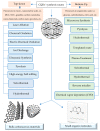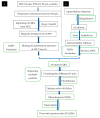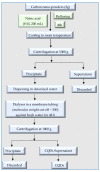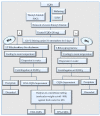Nanocellulose-Based Passivated-Carbon Quantum Dots (P-CQDs) for Antimicrobial Applications: A Practical Review
- PMID: 37376306
- PMCID: PMC10305638
- DOI: 10.3390/polym15122660
Nanocellulose-Based Passivated-Carbon Quantum Dots (P-CQDs) for Antimicrobial Applications: A Practical Review
Abstract
Passivated-carbon quantum dots (P-CQDs) have been attracting great interest as an antimicrobial therapy tool due to their bright fluorescence, lack of toxicity, eco-friendly nature, simple synthetic schemes, and possession of photocatalytic functions comparable to those present in traditional nanometric semiconductors. Besides synthetic precursors, CQDs can be synthesized from a plethora of natural resources including microcrystalline cellulose (MCC) and nanocrystalline cellulose (NCC). Converting MCC into NCC is performed chemically via the top-down route, while synthesizing CODs from NCC can be performed via the bottom-up route. Due to the good surface charge status with the NCC precursor, we focused in this review on synthesizing CQDs from nanocelluloses (MCC and NCC) since they could become a potential source for fabricating carbon quantum dots that are affected by pyrolysis temperature. There are several P-CQDs synthesized with a wide spectrum of featured properties, namely functionalized carbon quantum dots (F-CQDs) and passivated carbon quantum dots (P-CQDs). There are two different important P-CQDs, namely 2,2'-ethylenedioxy-bis-ethylamine (EDA-CQDs) and 3-ethoxypropylamine (EPA-CQDs), that have achieved desirable results in the antiviral therapy field. Since NoV is the most common dangerous cause of nonbacterial, acute gastroenteritis outbreaks worldwide, this review deals with NoV in detail. The surficial charge status (SCS) of the P-CQDs plays an important role in their interactions with NoVs. The EDA-CQDs were found to be more effective than EPA-CQDs in inhibiting the NoV binding. This difference may be attributed to their SCS as well as the virus surface. EDA-CQDs with surficial terminal amino (-NH2) groups are positively charged at physiological pH (-NH3+), whereas EPA-CQDs with surficial terminal methyl groups (-CH3) are not charged. Since the NoV particles are negatively charged, they are attracted to the positively charged EDA-CQDs, resulting in enhancing the P-CQDs concentration around the virus particles. The carbon nanotubes (CNTs) were found to be comparable to the P-CQDs in the non-specific binding with NoV capsid proteins, through complementary charges, π-π stacking, and/or hydrophobic interactions.
Keywords: antiviral therapy; carbon quantum dots; functionalization; microcrystalline cellulose; nanocrystalline cellulose; norovirus; passivation.
Conflict of interest statement
The authors declare no conflict of interest.
Figures









Similar articles
-
Cationic carbon quantum dots derived from alginate for gene delivery: One-step synthesis and cellular uptake.Acta Biomater. 2016 Sep 15;42:209-219. doi: 10.1016/j.actbio.2016.06.021. Epub 2016 Jun 16. Acta Biomater. 2016. PMID: 27321673
-
Synthesis of tungsten oxide/ amino-functionalized sugarcane bagasse derived-carbon quantum dots (WO3/N-CQDs) composites for methylene blue removal.Chemosphere. 2021 Aug;277:130300. doi: 10.1016/j.chemosphere.2021.130300. Epub 2021 Mar 18. Chemosphere. 2021. PMID: 33774232
-
Carbon Dots' Antiviral Functions Against Noroviruses.Sci Rep. 2017 Mar 31;7(1):519. doi: 10.1038/s41598-017-00675-x. Sci Rep. 2017. PMID: 28364126 Free PMC article.
-
Synthesis of Carbon Quantum Dots with Special Reference to Biomass as a Source - A Review.Curr Pharm Des. 2019;25(13):1455-1476. doi: 10.2174/1381612825666190618154518. Curr Pharm Des. 2019. PMID: 31258064 Review.
-
Eco-Friendly and Sustainable Pathways to Photoluminescent Carbon Quantum Dots (CQDs).Nanomaterials (Basel). 2023 Jan 30;13(3):554. doi: 10.3390/nano13030554. Nanomaterials (Basel). 2023. PMID: 36770515 Free PMC article. Review.
Cited by
-
Synthesis of sulfur-doped carbon quantum dots from Solanum nigrum for ciprofloxacin detection in yogurt samples and antibacterial activity.RSC Adv. 2025 Jul 31;15(33):27294-27299. doi: 10.1039/d5ra04505c. eCollection 2025 Jul 25. RSC Adv. 2025. PMID: 40746781 Free PMC article.
-
Synergistic Integration of Carbon Quantum Dots in Biopolymer Matrices: An Overview of Current Advancements in Antioxidant and Antimicrobial Active Packaging.Molecules. 2024 Oct 30;29(21):5138. doi: 10.3390/molecules29215138. Molecules. 2024. PMID: 39519777 Free PMC article. Review.
-
Synthesis, optical, and photocatalytic properties of cellulose-derived carbon quantum dots.Sci Rep. 2025 May 30;15(1):19027. doi: 10.1038/s41598-025-04453-y. Sci Rep. 2025. PMID: 40447736 Free PMC article.
References
-
- Hindi S.S., Abohassan R.A. Cellulosic microfibril and its embedding matrix within plant cell wall. Int. J. Innov. Res. Sci. Eng. Technol. 2016;5:2727–2734.
-
- Hindi S.S. Microcrystalline cellulose: The inexhaustible treasure for pharmaceutical industry. Nanosci. Nanotechnol. Res. 2017;4:22–31.
-
- Hindi S.S. Suitability of date palm leaflets for sulphated cellulose nanocrystals synthesis. Nanosci. Nanotechnol. Res. 2017;4:7–16. doi: 10.12691/nnr-4-1-2. - DOI
-
- Hindi S.S. Differentiation and synonyms standardization of amorphous and crystalline cellulosic products. Nanosci. Nanotechnol. Res. 2017;4:73–85.
-
- Hindi S.S. Nanocrystalline cellulose: Synthesis from pruning waste of Zizyphus spina christi and characterization. Nanosci. Nanotechnol. Res. 2017;4:106–114.
Publication types
Grants and funding
LinkOut - more resources
Full Text Sources
Research Materials
Miscellaneous

